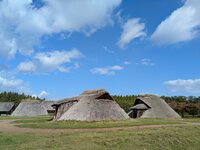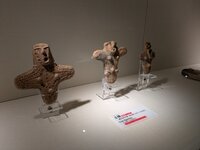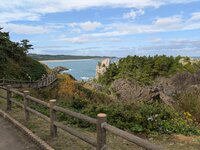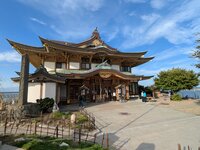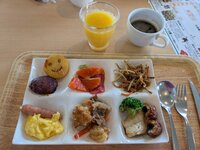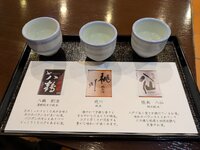It had seemed like a good idea when planning the trip - get as much of the travelling over with as quickly as possible. When it came down to it though, the trip from North Wales to Northern Japan was rather grueling: drive North Wales to London, 14 hour flight to Tokyo, Metro into town, train to Tokyo station, 4 hour Shinkansen to Shin Aomori, train into Aomori town, walk to hotel carrying luggage. You know you are tired when even Japanese station announcers get on your nerves! That said, the entire journey was pretty uneventful, with the only excitement being the Japanese Airlines pilot telling us repeatedly that there was to be be turbulence on route and on approach into Tokyo. Suffice to say there was nary a ripple on the coffee en route and the landing was not in the least bit sporty.
Aomori

Aomori is at the north of the big island (Honshu) and serves as a terminal for the ferry to the north island of Hokkaido (we are not going there). It is also the last stop on the Shinkansen before it disappears under the Sea of Japan, also Hokkaido-bound. More than just a trading and communications hub, Aomori is also famous for its apples and the town has been imaginatively nicknamed "Apple Town". It seem that everything is made of the ubiquitous apple here. Who doesn't like apple and brandy cake or apple curry?
Being in the north, a certain amount of northern weather is to be expected. Consequently, as the heavens opened we took a day trip to Hirosaki. This place is famous for its apples wouldn't you know! It is also famous for its cherry blossom, but not in October it isn't. The place has a 16th century castle in the typical wooden style. This castle is undergoing restoration and [ahem] fortification, but this time it's against earthquakes rather than marauding warriors. In order to achieve this, the workers relocated the entire castle Keep so that they could work on the foundations and walls. The building was kept open to the public during the entire escapade. Furthermore, members of the public could also help with the relocation process itself, by way of pulling very hard on ropes tied to the Keep whilst it was up on rollers. Not a particularly ingenious engineering solution, but full marks for recruiting cheap labour.

The local train from Aomori to Hirosaki passes through truly rural Japan. Needless to say, we were the only Westerners. To an extent, the rural north seems rather like the UK: a bit shabby and run-down, although "shabby" is a relative term where Japan is concerned.
Back in Aomori, we took a local bus out to visit the Art Gallery. This contained an extensive display of the works of Shikō Munakata whose distinguishing attributes seem to be that he was virtually blind and had more than a passing resemblance to Eric Morcambe. Surely to those Japanese in the know, he is a significant figure and worthy of admiration. To us heathens though, not so much. Luckily, out by the Art Gallery is San'nai-Maruyama iseki Special Historical Site. This is an archaeological site dating back to 3900BCE. Really, it's now a collection of reconstructed wooden huts, but the experts are still doing archaeology here and it has revealed some rather cool stuff, such as a 5000 year old woven basket that's pretty much intact. The remains seem to have been preserved by a combination of fluvial deposits and volcanic ash, which doesn't speak to a very good standard of living for the Jōmon people, but has left their legacy pretty well preserved. This is the largest Jōmon site in Japan, but it's still rather small.
Speaking of, we stayed in an APA Hotel in Aomori since we have used this chain before. Like their archaeological sites, Japanese rooms can be on the small side, but this one was supremely miniscule. So much so that we have cancelled one of our other bookings that was also in an APA and rebooked somewhere that is hopefully larger than a singularity. We shall see how that pans out when we get to Sendai.
Hachinohe
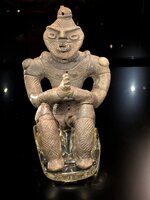
We chose to travel from Aomori to Hachinohe on the local train rather than the Shinkansen because it looked like it might be an interesting coastal journey. It did turn out to be that, but we also discovered that it is a bit of a favourite route for "train enthusiasts" who like the quaint nature of "One Man and His Train" and the rustic nature of the local stations. Train enthusiasts we are not, but there was a certain charm to the journey that the Shinkansen lacks - and we got to chat with some of the locals too.
There is also a bit of charm to the hotel in Hachinohe, which endeared itself to us by a) being larger than a postage stamp and b) offering free Sake tasting. What's not to like? Oh, yes, that's right! The constant thudding of the kids upstairs.
Those really old dudes the Jōmon feature here as well, housed as they are in the Korekawa Jōmon-kan Museum. This place showcases masses of their pottery and other artefacts including a national treasure in the form of a crouching person known as Gassho Dogu. There's only so many pottery figures one can view in a single sitting and so, after we had had our fill of historical artefacts, we dived into the Roku Yokocho lanes of Hachinohe to stroll the Izakaya (Japanese pubs) and to have our fill of gyoza dumplings.
Just outside Hachinohe at a place called "Same" is the start of the Michinoku Coastal
Trail (MCT) which runs South for 1000km along the coast to Soma City. We walked a small section of
it from Ōkuki just to get a taster. If walking from South to North, this would be the end of the
route, so we got to imagine how it would be to complete the entire walk but without having to
actually do it. The MCT is certainly scenic. At the very end of our walk in Same, we saw the rather
uninspiring board that marks the trail start/endpoint. We also saw the Kabushima Shrine which sits
majestically on a rocky outcrop jutting out into the Sea of Japan harbour. There
has been a Shinto shrine on this site since 1269 other than when it burned down in 2015 and was
rebuilt in 2020. This shrine is linked to the black-tailed gull although the Japanese know them as
the "Sea Cat", presumably to mask the fact they are essentially seagulls and thus hateful.
Apparently it is considered auspicious to be dumped on by these creatures although umbrellas are
offered as a courtesy to tourists who know better. Seemingly in an effort to mitigate the effect of
these flying abominations, along the MCT, we did witness the locals hosing down the beach.
¯\_(ツ)_/¯
After Hachinohe, we will continue our trundle down the coast on the local One Man trains to seek out more of the Michinoku Coastal Trail.
Some Pictures

